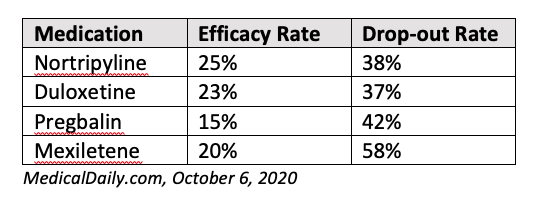Researchers Look at 4 Meds for Neuropathic Pain

Neuropathic pain, or pain caused by damage to the nervous system, can be hard to treat. It’s not as well understood as other types of pain, such as what you feel if you break a leg or have an abscessed tooth.
Researchers from The University of Kansas Medical Center, Kansas City looked at four commonly prescribed medications used to treat cryptogenic sensory polyneuropathy to see which might work best. Their findings? Two of the four medications should be considered as first-line treatment.
What are neuropathic pain and cryptogenic sensory polyneuropathy?
Neuropathic pain occurs when the nervous system malfunctions or is damaged. Peripheral neuropathic pain, also called peripheral neuropathy, affects the peripheral nerves, those found outside the spinal cord or brain.
More than 20 million people in the U.S. have some sort of neuropathic pain, often described as a burning, pins-and-needles sensation. Although it can occur anywhere in the body, the most commonly affected areas are the hands and feet. It can come and go, or it can be constant.
People with diabetes are at high risk of developing neuropathy, particularly in their feet and legs. This is due to nerve damage caused by years of fluctuating blood sugar levels.
Cryptogenic sensory polyneuropathy is the most common type of neuropathic pain among adults over 50. It’s also called idiopathic sensory polyneuropathy and can be caused by a number of conditions, including diabetic neuropathy, some types of cancer, HIV/AIDS, Parkinson’s disease, and deficiencies of vitamins B12, B1, and E, to name a few.
Managing neuropathic pain
Traditional pain relievers, such as ibuprofen or acetaminophen, don’t relieve nerve pain, so doctors have to look elsewhere. They often prescribe medications that people wouldn’t connect with pain relief, such as:
- Antidepressants, including nortriptyline and duloxetine
- Anti-seizure medications, including gabapentin and pregabalin
- Topical creams that contain pain-relieving properties, like lidocaine or capsaicin
The study
The University of Kansas study looked at about 400 participants who had neuropathic pain. The participants were divided into four groups, each of which received one of the medications:
- Nortriptyline – an antidepressant
- Duloxetine – another antidepressant
- Pregabalin – specifically for neuropathic pain
- Mexiletine – used to treat an irregular heartbeat
The study lasted for 12 weeks, with evaluations at 4, 8 and 12 weeks to see if there was pain relief. Successful results were when participants reported at least a 50% pain reduction.
"This study went beyond whether the drug reduced pain to also focus on adverse effects," lead researcher Richard Barohn, MD, said in a press release. "As the first study of its kind, we compared these four drugs in a real-life setting to provide physicians with a body of evidence to support the effective management of peripheral neuropathy and to support the need for newer and more effective drugs for neuropathic pain." Dr. Barohn is the executive vice chancellor for health affairs at the University of Missouri.
The results
According to the study’s findings, nortriptyline was the most effective medication of the four, followed by duloxetine. Mexiletene had the highest dropout rate.

"There was no clearly superior performing drug in the study," Dr. Barohn said. "However, of the four medications, nortriptyline and duloxetine performed better when efficacy and dropouts were both considered. Therefore, we recommend that either nortriptyline or duloxetine be considered before the other medications we tested."
The take-home
People with neuropathic pain sometimes must try many different treatments, both medical and complementary (like acupuncture), before they find something that gives some relief. If you have neuropathic pain, speak with your physician, and see what options may be right for you.
Published by Medicaldaily.com



























